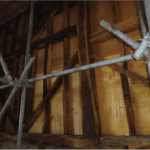How to Identify and Control Dry Rot
Dry rot is a fungus that destroys wood and which exists in many parts of the world. Despite the name, dry rot requires moisture, very often the source being from leaks such as downpipes, gutters and plumbing etc., which result in the timbers being in contact with moisture for prolonged periods.
In homes and buildings that are affected with dampness, dry rot is most likely to occur within the woodwork of the building, often becoming apparent on skirting boards and other joinery.
First you need to identify whether it is actually dry rot that is affecting the wood or if it is any other type of fungus, such as wet rot. Dry rot can also travel through other building materials besides timber such as brickwork, masonry and wall plaster. As a result, outbreaks can be severe and the fungus can spread quite quickly through the building.
Signs of dry rot
Signs of dry rot can be when the wood shrinks, darkens or cracks, which may be a sign that it has been infected with dry rot . Sometimes a mycelium may develop which can appear as a white/grey coloured skin with patches of lilac and yellow, especially when conditions are less humid. During high humidity, a layer which resembles white cotton wool can develop on the wood.
 Fruiting bodies may also develop, resulting in a rust red coloured dust. Furthermore, wood decay due to fungi often produces a damp musty odour.
Fruiting bodies may also develop, resulting in a rust red coloured dust. Furthermore, wood decay due to fungi often produces a damp musty odour.
You should be aware that dry rot can be a very destructive fungus and can cause severe damage to the structure of your building. For this reason, a professional timber and damp expert company such as Kenwood Plc should be called in to inspect the damage and provide recommendations for repair.
Where can dry rot occur?
 Only in cases where timber is damp and has a high moisture content will dry rot occur. Hence the core solution to this problem is to remove the source of damp and moisture in order to prevent dry rot. Timber could become damp due to leaking pipes, shower and bath areas, leaking roofs, dampness coming in through outer walls or the lack of an effective damp proof course.
Only in cases where timber is damp and has a high moisture content will dry rot occur. Hence the core solution to this problem is to remove the source of damp and moisture in order to prevent dry rot. Timber could become damp due to leaking pipes, shower and bath areas, leaking roofs, dampness coming in through outer walls or the lack of an effective damp proof course.
During the drying out period, control measures must be taken such as masonry sterilisation, irrigation and replacement of the affected timbers to prevent reoccurrence. Furthermore, wood preservatives are a good option to secure the timber as they will increase its resistance to fungi.


